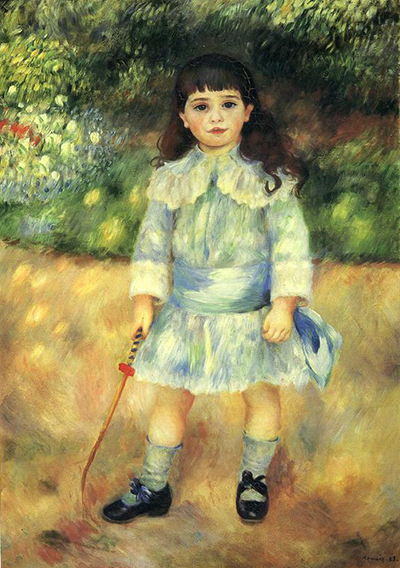This oil on canvas portrait was painted in 1885, later on in the artist's career
It was was created at a time of artistic turmoil for not only Renoir but also his peers. By definition an impressionist piece, Renoir is here exploring the use of harder lines and outlines in what was ultimately known as Renoir's "hard" or "Ingres" style.
The subject of the painting is Etienne Goujon, a 5 year old boy and the son of a French senator. He is dressed in clothes that would be more commonly seen on a little girl today but was common for boys in the 1800s. The light blue smock, white ruffles and pale skin of the child allow a pleasant contrast in colour to the browns, greens and yellows of the garden behind.
Whilst the garden is painted with the free brushstrokes synonymous with impressionism, the child is presented with a defined outline in both face and limbs, further adding to the contrast. This definition was a direct result of Renoir's exploration of alternative artworks and styles, particularly those of Ingres and Raphael.
The turmoil presented between free brush strokes and definition is evident throughout the subject, with the free and rough outlines of the clothes in contrast to the defined edges of the face.
Despite his obvious conflict with style, the piece of art is consistent with the warmth and colour often provided by Renoir, particularly noted in his paintings of women. The multiple colours of the garden are reflected in the lively smock and the viewer is drawn to the youthfulness of the subject and the freshness of his features.
Yet, looking further, the viewer is presented with very serious features within the child's face. This grave expression is unchildlike and out of keeping with the overall vibrancy seen throughout the rest of the painting. Perhaps here, Renoir was reflecting his thoughts on the evolution of artistic style. The most famous paintings from Renoir were Luncheon of the Boating Party, Dance at Le Moulin de la Galette and Dance at Bougival.
It was in the decade following this painting that Renoir abandoned use of hard lines in his work altogether and his work became much more 'free' and undefined. Such works would include Party in the Country at Berneval and Roses in a Vase, each continuing to display Renoir's trademark warmth and beauty.
Renoir is now widely recognised as one of the leading pioneers and artists of the impressionist period. Along with several other artists in 1974, he produced the world's first impressionist art exhibition, thus beginning the movement. Despite the conflict with style mid career, he returned to his roots and has a vast catalogue of highly celebrated pieces.
The painting is now privately owned but can be seen on display in the Hermitage Museum, Saint Petersburg, Russia.




